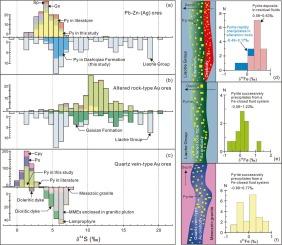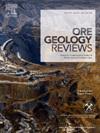华北克拉通辽东半岛黄铁矿原位Fe-S同位素对金和多金属矿床成矿来源和成矿过程的约束
IF 3.2
2区 地球科学
Q1 GEOLOGY
引用次数: 0
摘要
华北克拉通东部地区广泛分布着大量金矿和多金属矿床。这些矿床与岩浆岩至长英岩尖晶岩有关,并赋存于前寒武纪基底或中生代花岗岩中。然而,成矿流体中金和其他金属的来源仍存在争议。在此,我们介绍了中国辽东半岛各种金矿床和铅锌(银)矿床黄铁矿的原位S、F同位素和微量元素含量。武隆矿床中中生代花岗岩包裹的石英脉型金矿床中的黄铁矿具有相对均匀的类似岩浆的S同位素(δ34S值为0.9‰至2.5‰)和Co/Ni比值,表明硫的来源以及推断矿石流体/物质很可能来自中生代岩浆。相比之下,青城子矿田前寒武纪基底所赋存的金矿床和铅锌(银)矿床的黄铁矿的δ34S值较高且变化较大(湾底沟蚀变岩型金矿床的δ34S值为9.7‰至12.7‰,而青城子矿田前寒武纪基底所赋存的金矿床和铅锌(银)矿床的δ34S值为4.7‰至8.5‰)。西曲沟铅锌矿床和镇子沟铅锌银矿床的δ34S值为4.7‰至8.5‰),与母岩的δ34S值相同,表明壁岩中的金和其他金属对矿床有重要贡献。各矿床黄铁矿的δ56Fe值不尽相同,铅锌金矿床为0.08‰至0.63‰,蚀变岩型金矿床为-0.58‰至1.23‰,石英脉型金矿床为-0.68‰至0.77‰,表明矿化过程各不相同。黄铁矿(δ56Fe为负值)在蚀变岩中快速沉淀,随后黄铁矿(δ56Fe为正值)在铁-开放热液系统中的残余流体中沉积,在强烈的成矿流体-岩壁作用过程中形成铅锌银矿化,而弱的流体-岩壁作用和铁-封闭热液系统中的黄铁矿沉淀促成了金矿化。我们的观测结果为不同的金和多金属矿床的各种来源和成矿过程提供了有力的Fe-S同位素证据。本文章由计算机程序翻译,如有差异,请以英文原文为准。

Pyrite in-situ Fe–S isotope constraints on the ore-forming sources and mineralization processes of gold and polymetallic deposits in the Liaodong Peninsula, North China Craton
Plenty of gold and polymetallic deposits are widespread in the eastern part of the North China Craton. They are associated with mafic to felsic dikes and hosted by Precambrian basement or Mesozoic granitoids. However, the sources of gold and other metals in the ore-forming fluids remain controversial. Here we present in-situ S and Fe isotopes and trace element contents of pyrites from various gold and Pb–Zn–(Ag) deposits in the Liaodong Peninsula, China. Pyrites from quartz vein-type gold deposit hosted by Mesozoic granites in the Wulong deposit have relatively homogeneous magmatic-like S isotopes (δ34S values of 0.9 ‰ to 2.5 ‰) and Co/Ni ratios, indicating derivation of sulfur and, by inference, of ore fluids/materials most likely from Mesozoic magmas. In contrast, pyrites from gold and Pb–Zn–(Ag) deposits in the Qingchengzi orefield hosted by Precambrian basement have high and variable δ34S values (9.7 ‰ to 12.7 ‰ for the Wandigou altered rock-type gold deposit and 4.7 ‰ to 8.5 ‰ for the Xiquegou Pb–Zn deposit and the Zhenzigou Pb–Zn–Ag deposit), identical to those of host rocks, indicating the important contributions of gold and other metals from wall rocks to the ore deposits. Pyrites from the various deposits have variable δ56Fe values of 0.08 ‰ to 0.63 ‰ for the Pb–Zn–Ag deposit, –0.58 ‰ to 1.23 ‰ for the altered rock-type gold deposit, and –0.68 ‰ to 0.77 ‰ for the quartz vein-type gold deposit, indicating distinct mineralization processes. Rapid precipitation of pyrites (with negative δ56Fe values) in the alteration rock and subsequent deposition of pyrites (with positive δ56Fe values) from the residual fluids in an Fe-open hydrothermal system during intensive ore-forming fluid-wall rock interaction account for the Pb–Zn–Ag mineralization, while weak fluid-rock interaction and pyrites precipitation from a Fe-closed hydrothermal system contribute to gold mineralization. Our observations provide a robust Fe–S isotope evidence for the contribution of various sources and metallogenic processes for distinct gold and polymetallic deposits.
求助全文
通过发布文献求助,成功后即可免费获取论文全文。
去求助
来源期刊

Ore Geology Reviews
地学-地质学
CiteScore
6.50
自引率
27.30%
发文量
546
审稿时长
22.9 weeks
期刊介绍:
Ore Geology Reviews aims to familiarize all earth scientists with recent advances in a number of interconnected disciplines related to the study of, and search for, ore deposits. The reviews range from brief to longer contributions, but the journal preferentially publishes manuscripts that fill the niche between the commonly shorter journal articles and the comprehensive book coverages, and thus has a special appeal to many authors and readers.
 求助内容:
求助内容: 应助结果提醒方式:
应助结果提醒方式:


